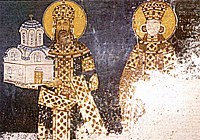 |
|
 |
The West - The
Balkans
 he military
and financial weakness of the Byzantine Empire forced
Andronikos II to rely
mostly on diplomacy to secure the frontiers of his state. Following the death of he military
and financial weakness of the Byzantine Empire forced
Andronikos II to rely
mostly on diplomacy to secure the frontiers of his state. Following the death of
 his wife, Anna of Hungary, he took as his second wife in 1284 Irene of Montferrat, and secured for himself his wife's claim to the kingdom of Thessalonike. He endeavoured to achieve the same result by marrying his son,
Michael IX, to the daughter of the titular emperor of
Constantinople, Philip, and granddaughter of Baldwin I
I,
Catherine of Courtenay, whom the Latins saw as titular Empress of Constantinople. This marriage did not finally take place, however. Nevertheless, although the Latins, with the Kingdoms of France and Naples in the forefront, continued to plot against Byzantium, they did not, at this time, constitute a serious threat for the Empire. his wife, Anna of Hungary, he took as his second wife in 1284 Irene of Montferrat, and secured for himself his wife's claim to the kingdom of Thessalonike. He endeavoured to achieve the same result by marrying his son,
Michael IX, to the daughter of the titular emperor of
Constantinople, Philip, and granddaughter of Baldwin I
I,
Catherine of Courtenay, whom the Latins saw as titular Empress of Constantinople. This marriage did not finally take place, however. Nevertheless, although the Latins, with the Kingdoms of France and Naples in the forefront, continued to plot against Byzantium, they did not, at this time, constitute a serious threat for the Empire.
The other opponents of Byzantium in the Balkans, Epiros and Thessaly, were feuding with each other and the Byzantine Emperor took advantage of the situation to intervene dynamically in 1290. However, the intervention of the Serbs did not allow Andronikos II to impose his rule over these lands. In 1296 the Serbian king,
Milutin, launched an attack against
the Byzantines, defeated them and took the city of Dyrrachion. As Andronikos was in no position to face the Serbian forces, he decided to make peace with the king of Serbia. The treaty was signed in the spring of 1299, after long negotiations presided over by Theodore Metochites. Milutin married the five-year-old daughter of Andronikos II, Simonis, who brought to him as her dowry the territories that the Serbian king had already conquered north of the Ohrid-Prilapos and Stip line.
See also: Theodore Metochites
|